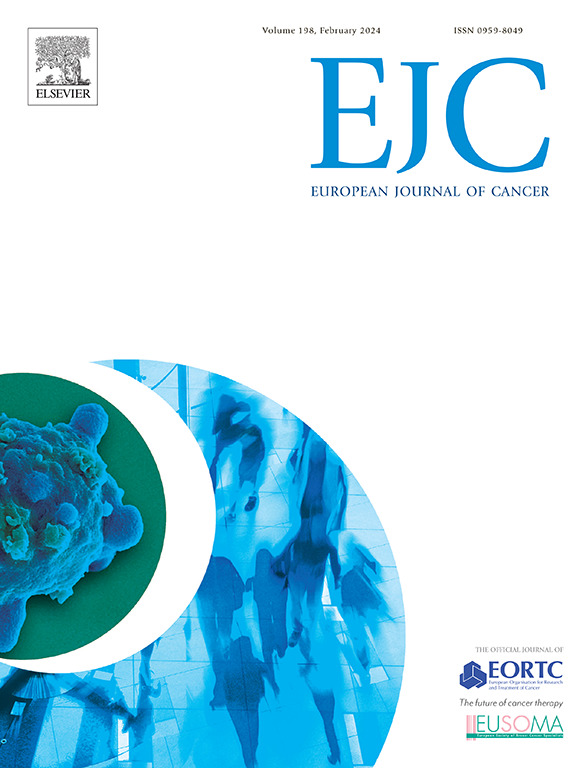Immunotherapy followed by cetuximab in locally advanced/metastatic cutaneous squamous cell carcinomas: the I-TACKLE trial
IF 7.6
1区 医学
Q1 ONCOLOGY
引用次数: 0
Abstract
Background
Immunotherapy with pembrolizumab and cemiplimab achieves an overall response rate (ORR) of 34–51 % in locally advanced/metastatic (LA/M) cSCC, but primary and acquired resistance remains a challenge. This study evaluates whether adding cetuximab to pembrolizumab can overcome resistance by reducing immune escape.
Patients and methods
I-TACKLE is a phase II, open-label trial conducted at three Italian centers. Patients received intravenous pembrolizumab 200 mg every 3 weeks, and cetuximab was added in cases of stable disease or progression. The primary endpoint was cumulative ORR by a single agent or by combination strategy. Secondary endpoints included safety, progression-free survival (PFS), overall survival (OS), and response duration.
Results
From May 2019 to April 2021, 43 patients were enrolled and treated with pembrolizumab, and 23 received combination therapy. Median treatment durations were 3 months (pembrolizumab) and 4 months (combination). Cumulative ORR was 63 % [95 % CI 48–77], with 19/43 (44 %) responding to pembrolizumab and 8/21 (38 %) responding to the combination after resistance. Both patients experiencing an acquired resistance to pembrolizumab obtained partial response when cetuximab was introduced. Overall, 10/23 (44 %) responded to the combination. One-year PFS was 51 % with pembrolizumab and 42 % with combination therapy. Grade 3–4 treatment-related adverse events occurred in 7/43 (16 %) during pembrolizumab and 8/23 (35 %) during combination therapy, primarily dermatitis (30 %).
Conclusions
In LA/M cSCC, the addition of cetuximab to pembrolizumab reverts primary and acquired resistance with manageable toxicities. This sequential approach warrants further study.
免疫治疗后西妥昔单抗治疗局部晚期/转移性皮肤鳞状细胞癌:I-TACKLE试验
在局部晚期/转移性(LA/M) cSCC中,pembrolizumab和cemiplimab联合免疫治疗的总有效率(ORR)为34 - 51% %,但原发性和获得性耐药仍然是一个挑战。本研究评估在派姆单抗中加入西妥昔单抗是否可以通过减少免疫逃逸来克服耐药性。患者和方法si - tackle是一项在三个意大利中心进行的II期开放标签试验。患者每3周静脉注射派姆单抗200 mg,在病情稳定或进展的情况下加入西妥昔单抗。主要终点是单药或联合用药的累计ORR。次要终点包括安全性、无进展生存期(PFS)、总生存期(OS)和反应持续时间。结果2019年5月至2021年4月,入组43例患者接受派姆单抗治疗,其中23例接受联合治疗。中位治疗持续时间为3个月(派姆单抗)和4个月(联合)。累积ORR为63 %[95 % CI 48-77],其中19/43(44 %)对派姆单抗有效,8/21(38 %)耐药后对联合用药有效。当引入西妥昔单抗时,两例对派姆单抗出现获得性耐药的患者均获得部分缓解。总体而言,10/23(44. %)对联合治疗有反应。pembrolizumab组一年的PFS为51% %,联合治疗组为42% %。3-4级治疗相关不良事件在派姆单抗期间发生7/43(16 %),在联合治疗期间发生8/23(35 %),主要是皮炎(30 %)。结论在LA/M cSCC中,西妥昔单抗联合派姆单抗可逆转原发性和获得性耐药,且毒性可控。这种循序渐进的方法值得进一步研究。
本文章由计算机程序翻译,如有差异,请以英文原文为准。
求助全文
约1分钟内获得全文
求助全文
来源期刊

European Journal of Cancer
医学-肿瘤学
CiteScore
11.50
自引率
4.80%
发文量
953
审稿时长
23 days
期刊介绍:
The European Journal of Cancer (EJC) serves as a comprehensive platform integrating preclinical, digital, translational, and clinical research across the spectrum of cancer. From epidemiology, carcinogenesis, and biology to groundbreaking innovations in cancer treatment and patient care, the journal covers a wide array of topics. We publish original research, reviews, previews, editorial comments, and correspondence, fostering dialogue and advancement in the fight against cancer. Join us in our mission to drive progress and improve outcomes in cancer research and patient care.
 求助内容:
求助内容: 应助结果提醒方式:
应助结果提醒方式:


